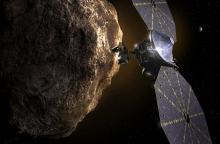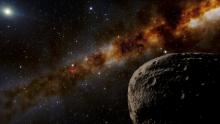Listen to today's episode of StarDate on the web the same day it airs in high-quality streaming audio without any extra ads or announcements. Choose a $8 one-month pass, or listen every day for a year for just $30.
You are here
Jupiter and Mercury
The biggest and smallest of the solar system’s major planets are staging a get-together in the dawn sky. For the next few days, they’ll be separated by no more than a degree or two — less than the width of your finger held at arm’s length. They’re so low in the sky, though, that there’s not much time to look for them.
The brighter of the two worlds is also the bigger one: mighty Jupiter. Its companion is little Mercury, which is also the Sun’s closest planet.
Their appearance is deceiving — Jupiter far outranks Mercury in every category. It’s about 30 times Mercury’s diameter, and close to six thousand times its mass. In fact, Jupiter is more massive than all the other planets and moons combined.
Mercury looks so bright because it’s fairly close to Earth and to the Sun. So it receives a lot of sunlight, and it reflects a good amount of it in our direction.
Jupiter looks so bright because of its huge size, and because the clouds that top its atmosphere reflect more than half of the sunlight that strikes them. That makes the giant planet a giant presence in our night sky.
Look for Jupiter shining brightly quite low in the east-southeast as twilight begins to paint the dawn sky the next few days. Fainter Mercury will stand close above Jupiter tomorrow, then slide down to the left of the giant planet by Saturday. After that, Jupiter will pull away from Mercury, climbing higher into the sky as Mercury drops toward the Sun.
Script by Damond Benningfield





